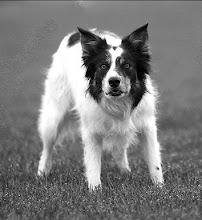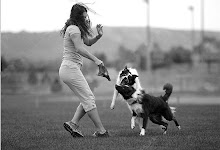So one of the problems with taking four days off to attend an agility seminar is when you return to work, it takes you a whole week just to catch up! '
The seminar was amazing (as I knew it would be) and although I had taken some of the same sessions last year, I came away with a notebook filled with notes and many light bulb moments.
Summit was still in rehab so I did all the Masters handling sessions and the Balancing Cues session with Sage. She did great and even though I really wanted to run Summit in the Balancing Cues session (the timing between him and Sage is very different), I still learned a lot by running Sage. It really was about the handler learning how to balance cues rather than strategy.
In the Balancing Cues session with Mary Ellen there were several learning opportunities and new understanding of how the balance of cues works.
1. Of the 6 cues available in APHS, ideally you have a 4-2 ratio of forward and turning cues. A 3-3 ratio (50/50 split) is too "balanced" and there is not enough differentiation between forward and turning.
2. Experienced dogs can cover for the incorrect cue ration (they recognize patterns and will anticipate) but you don't want to encourage this.
3. Perpendicular and Parallel Forward Sends: Parallel creates a much more difficult jumping effort for the dog and is important to practice.
I also came away with a much clearer understanding of why you use the OA for a Rear Cross on the flat. It differentiates it from a push. And of course, the IA is used for a RC over a jump because of the need for an additional forward cue.
APHS Masters Handling with Mary Ellen-
1. LOPivot... used to cue extension and the turn happens on the flat. Especially useful if you need the dog to bypass an obstacle or take the backside of the jump.
2. Tunnel discriminations are examples of convergence (well of course! but I never thought of it that way).
3. Relative Collection - really means a "turn" not collection since the dog is really deciding what he needs to clear the jump and turn.
4. Tight turns (involving true collection) vs. relative collection (ie., a regular turn) is all about the NET number of strides on a sequence not about getting the tightest turns. Example, in a 4-jump pinwheel configuration, handler may cue a tight turn over the first jump but then that sets the dog up to have to take two strides to get to the second jump vs. if the first jump was taken in extension and the dog had only to take a single stride to get to the second jump. Still end up with the same NET number of strides whether the dog turns with extenion or collection. Many times a dog can be faster taking jumps in extension and having wider turns (can set them up better for the next sequence as well) vs. a dog who is jumping with collection and having tighter turns but adding more strides between jumps.
Last year I took the full day APHS Foundation and Basic Skills from Mary Ellen and this year Jenn taught it. It was very interesting to see the slight differences. I learned a lot again this year in the session and some concepts were clairified.
Soleil did really well in the full day Foundation and Advanced Flatwork on Monday. We practiced the turns on the flat as well as the recalls to heel on the flat in the morning (as well as some fun stuff from Mary Ellen's DVD). That afternoon we worked Sends to cones and did some sequencing with three cones incorporating the turns on the flat (except for the push).
Mary Ellen was impressed with Soleil's toy/tug drive. At first she said it was probably not a good idea to practice "It's Your Choice" with toys with a Sheltie (just food). But after seeing Soleil bouncing up in the air to grab the toy in my hand while I was trying to do some cone sequencing, she told me, yes, probably not a bad idea to do a bit of "It's Your Choice" with toys too.
So there are the highlights of the seminar. I've been incorporating all I learned in Soleil's training sessions. It is really great to have new stuff to work on and have a deeper understanding of the APHS handling system as well as improving our mechanics with the turns on the flat and RTH presentations.
Summit had a PT session yesterday and he is back to 100 percent. Now I am gradually working on conditioning. We are doing thirty minutes of walking/trotting, three jump grids, yoga ball work, stretching, and some yoga dog positions. He should be ready by the second week of March for a three day USDAA trial.
Since the snow has melted the last few days, we've been able to get outside to train and I will film some of the cone sequencing with Soleil.
Heart Health and Happy New Year
6 days ago









7 comments:
Thanks for putting on the seminar. Strummer and I had a great time and learned a lot. Hopefully they'll come back next year!
Wow - lots of great info there! I will have to reread it all. Your understanding of APHS is so much deeper than mine!
Glad to know Summit is 100% and is now getting back into shape!
WOW, that looks like such a jam packed seminar full of some great info, I can not imagine how much you got out of it when just reading your short posting I feel like I have got a ton!!!!
i would love to hear much more about the LoPivot if you ever have time! I have been feeling like here is a piece missing in my understanding of that situation you described
Sounds great. I liked the infor you posted about the tight turns and strides. Thanks.
wow sounds like an awesome seminar - great write up! we did the cone stuff in the fx/rx seminars as well, man I love that stuff!
So true about the net number of strides. Great write up. Soleil seems to get cuter each time you post, if that is possible? circles and barking = shelties :-)
Post a Comment